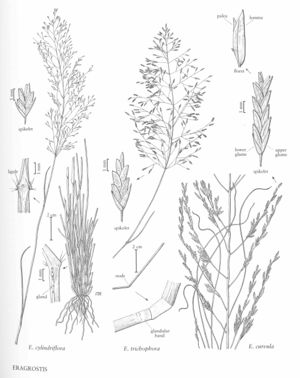Difference between revisions of "Eragrostis curvula"
FNA>Volume Importer |
FNA>Volume Importer |
||
| Line 8: | Line 8: | ||
|name=Eragrostis curvula var. conferta | |name=Eragrostis curvula var. conferta | ||
|authority=unknown | |authority=unknown | ||
| − | }}{{Treatment/ID/Synonym | + | }} {{Treatment/ID/Synonym |
|name=Eragrostis chloromelas | |name=Eragrostis chloromelas | ||
|authority=unknown | |authority=unknown | ||
| Line 23: | Line 23: | ||
-->{{Treatment/Body | -->{{Treatment/Body | ||
|distribution=Wash.;Del.;W.Va.;Pacific Islands (Hawaii);Fla.;Puerto Rico;N.J.;N.Mex.;Tex.;La.;Tenn.;N.Y.;Pa.;Va.;Colo.;Calif.;Ala.;Ark.;Ill.;Ga.;Ariz.;Md.;Mass.;Ohio;Utah;Mo.;Oreg.;Kans.;Okla.;Miss.;Ky.;N.C.;S.C. | |distribution=Wash.;Del.;W.Va.;Pacific Islands (Hawaii);Fla.;Puerto Rico;N.J.;N.Mex.;Tex.;La.;Tenn.;N.Y.;Pa.;Va.;Colo.;Calif.;Ala.;Ark.;Ill.;Ga.;Ariz.;Md.;Mass.;Ohio;Utah;Mo.;Oreg.;Kans.;Okla.;Miss.;Ky.;N.C.;S.C. | ||
| − | |discussion=<p>Eragrostis curvula is native to southern Africa. It is often used for reclamation because it provides good ground cover but, once introduced, it easily escapes. In the Flora region, it grows on rocky slopes, at the margins of woods, along roadsides, and in waste ground, at 20-2400 m, usually in pine-oak woodlands, and yellow pine and mixed hardwood forests.</p> | + | |discussion=<p><i>Eragrostis curvula</i> is native to southern Africa. It is often used for reclamation because it provides good ground cover but, once introduced, it easily escapes. In the Flora region, it grows on rocky slopes, at the margins of woods, along roadsides, and in waste ground, at 20-2400 m, usually in pine-oak woodlands, and yellow pine and mixed hardwood forests.</p> |
|tables= | |tables= | ||
|references= | |references= | ||
| Line 44: | Line 44: | ||
|publication year= | |publication year= | ||
|special status= | |special status= | ||
| − | |source xml=https://jpend@bitbucket.org/aafc-mbb/fna-data-curation.git/src/ | + | |source xml=https://jpend@bitbucket.org/aafc-mbb/fna-data-curation.git/src/8f726806613d60c220dc4493de13607dd3150896/coarse_grained_fna_xml/V25/V25_116.xml |
|subfamily=Poaceae subfam. Chloridoideae | |subfamily=Poaceae subfam. Chloridoideae | ||
|tribe=Poaceae tribe Cynodonteae | |tribe=Poaceae tribe Cynodonteae | ||
Revision as of 16:28, 18 September 2019
Plants perennial; cespitose, forming innovations at the basal nodes, without glands. Culms (45)60-150 cm, erect, glabrous or glandular. Sheaths with scattered hairs, hairs to 9 mm; ligules 0.6-1.3 mm; blades 12-50(65) cm long, 1-3 mm wide, flat to involute, abaxial surfaces glabrous, sometimes scabridulous, adaxial surfaces with scattered hairs basally, hairs to 7 mm. Panicles 16-35(40) cm long, (4)8-24 cm wide, ovate to oblong, open; primary branches 3-14 cm, diverging 10-80° from the rachises; pulvini glabrous or not; pedicels 0.5-5 mm, appressed, flexible. Spikelets 4-8.2(10) mm long, 1.2-2 mm wide, linear-lanceolate, plumbeous to yellowish, with 3-10 florets; disarticulation irregular to acropetal, proximal rachilla segments persistent. Glumes lanceolate, hyaline; lower glumes 1.2-2.6 mm; upper glumes 2-3 mm; lemmas 1.8-3 mm, ovate, membranous, lateral veins conspicuous, apices acute; paleas 1.8-3 mm, hyaline to membranous, apices obtuse; anthers 3, 0.6-1.2 mm, reddish-brown. Caryopses 1-1.7 mm, ellipsoid to obovoid, dorsally compressed, adaxial surfaces with a shallow, broad groove or ungrooved, smooth, mostly translucent, light brown, bases often greenish. 2n = 40, 50.
Distribution
Wash., Del., W.Va., Pacific Islands (Hawaii), Fla., Puerto Rico, N.J., N.Mex., Tex., La., Tenn., N.Y., Pa., Va., Colo., Calif., Ala., Ark., Ill., Ga., Ariz., Md., Mass., Ohio, Utah, Mo., Oreg., Kans., Okla., Miss., Ky., N.C., S.C.
Discussion
Eragrostis curvula is native to southern Africa. It is often used for reclamation because it provides good ground cover but, once introduced, it easily escapes. In the Flora region, it grows on rocky slopes, at the margins of woods, along roadsides, and in waste ground, at 20-2400 m, usually in pine-oak woodlands, and yellow pine and mixed hardwood forests.
Selected References
None.
